Filmetrics F20-EXR thin-film analyzer can be used to measure thickness of thin films or transmission of light through substrates. Transmission is measured only at 180 degrees. The wavelength range is 390-1700nm at intervals of 1nm. It is capable of measuring thicknesses between 15nm and 250um. This page only describes the % transmission measurements and not thickness calculations.
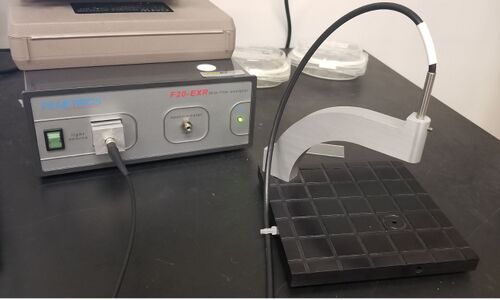
This system is located in M&M 532 (Michigan Technological University). Access may be granted after training by Dr. Peter Moran (pdmoran@mtu.edu). Alternatively, please contact Dr. Chito Kendrick (cekendri@mtu.edu) for more details regarding access/training.
You need[edit | edit source]
- a 1/16" hex key
- fiber optic cable
- spacer (10-15cm tall)
- your sample
Procedure[edit | edit source]
- Switch on the light source on the Filmetrics system. The light source should be on for at least 5-10 minutes before the measurement is made.
- Set up the hardware to operate in transmission mode by connecting the first fiber optic cable from the light source to the spring loaded set screw on the top arm of the machine.
The spectrometer input is connected to the bottom on the sample holder using a second fiber optic cable. To do this and to eliminate bends in the cable, use a 2 metre long cable and elevate the instrument at least 10-15cm. To fasten this fiber optic cable, you will need a 1/16" hex key.
Detailed instructions to do this (along with a schematic) are available in the "Help" section of the software.
- Open Filmmetrics software
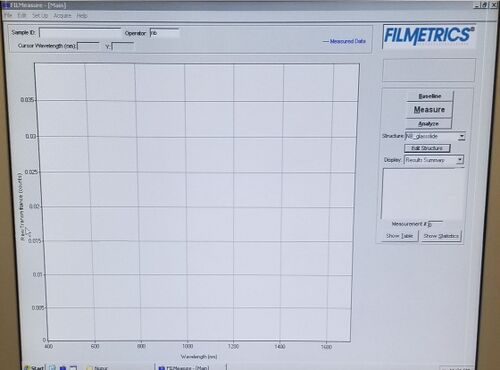
- Edit structure: Use the structure in the image for a plain glass slide. If your slide has a coating on it, please add it here.
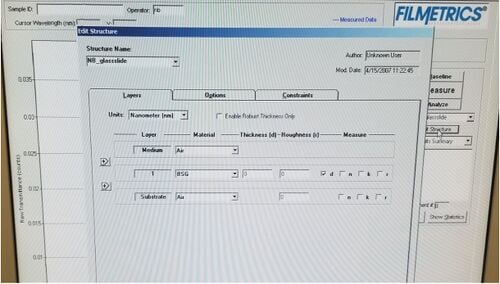
- On the "Options" tab on the same "Edit Structure" window, choose "Transmission" and save and exit settings.
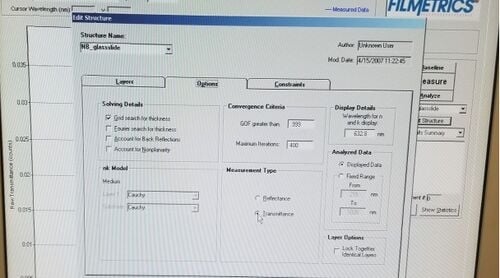
- Under the "Set Up" drop down menu on the main window select "Transmittance Mode".
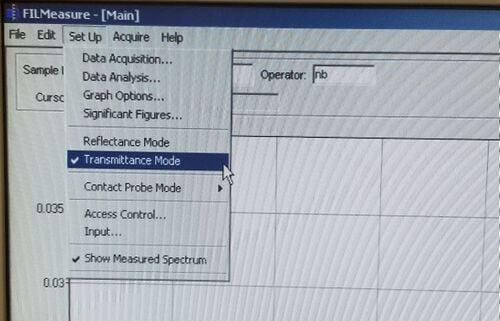
- Calibrate the system by doing a baseline measurement. Click "Baseline" on the main window (right side) and follow instructions as shown in the image. If you have a plain glass slide, transmittance of reference standard is 1 (air). If your sample has a coating on the enter transmittance of the substrate or select from drop down menu.
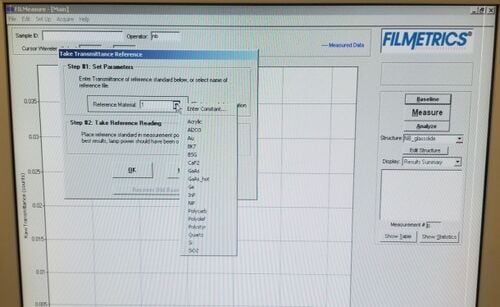
- After both the "in light" and "dark" baseline measurements are done, place your sample on the sample holder and click "Measure". This should give you a plot of % Transmittance vs wavelength. Repeat 3X times.
- Save your data to your folder in an acceptable format.
- Shut down: Close the software window and turn off the Filmetrics light source.
Data analysis[edit | edit source]
- The system only measures at wavelengths between 390nm and 1700nm at intervals of 1nm. While this range may not be changed, the horizontal axis may be changed to focus on a smaller range using Set Up -> Graph Options. Similarly, the vertical axis may also be changed to only reflect a part of the measurement.
- The software smoothens data for optimal viewing. The smoothening parameters can be altered using Set Up -> Data Analysis Parameters.
- The number of significant figures in the measurements may be set up to be between 4 and 7 using Set Up -> Significant Figures. 5 significant figures are usually sufficient for transmittance measurements on glass substrates.
- According to the manual, the error in measurement should be less than 1%. However, this depends on uniformity of the light source and works best on transparent or semi-transparent substrates of very low surface roughness. Opaque or very rough samples may not be used with this system.
- Most users have seen excellent repeatability with this system during transmittance measurements ( +/- 0.01%).
- Each scan takes only a few seconds (<2). Hence, this is a great tool for instantly getting transmission data from a sample.
NOTE: The computer that is used for this system has a faulty display adapter (as on July 15, 2019). Screenshots will not work. Always save your raw data as .csv and use a different software of your choice to plot it.

